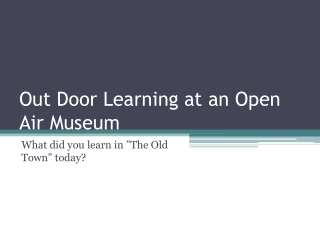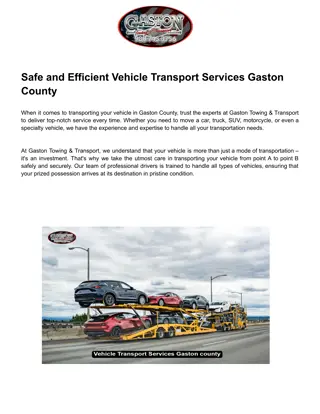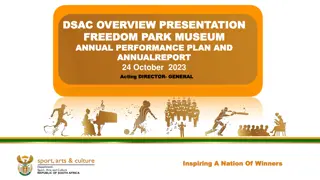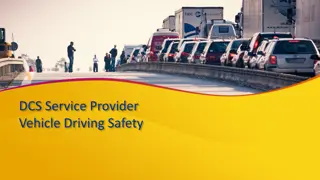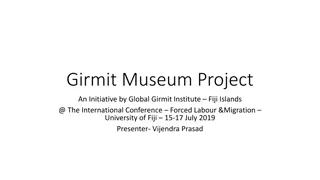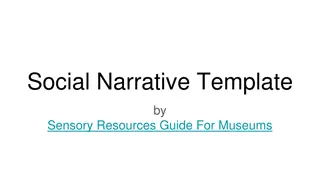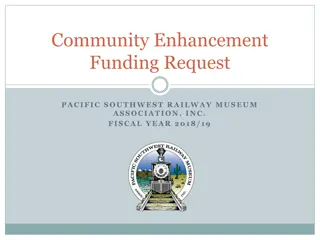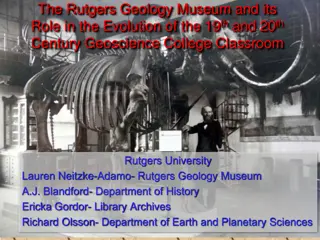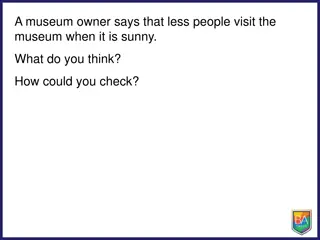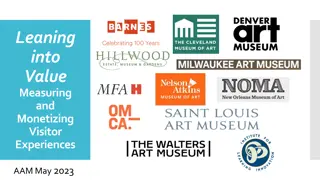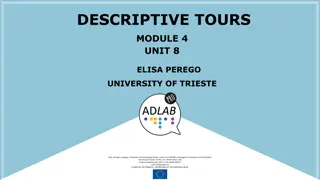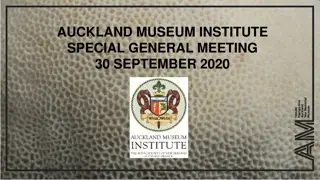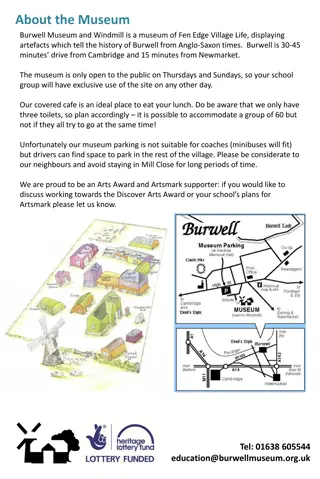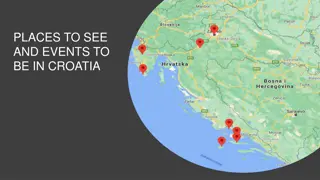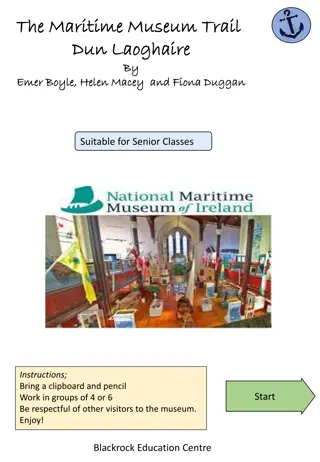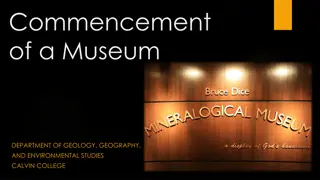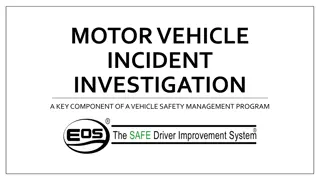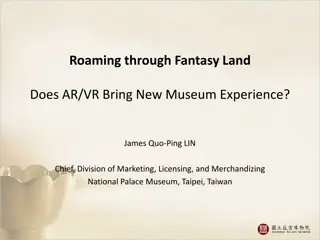Ground Guide Course for Vehicle Safety at OntR Museum
Introduction to a course on ground guiding for vehicle safety at OntR Museum. The course covers assisting drivers in navigating safely in controlled environments to protect vehicles, staff, and visitors. Topics include ground guide overview, safety considerations, linear and turning movements, and essential signals. The importance of ground guiding is emphasized due to driver blind zones and the need to prevent accidents with priceless artifacts. The course aims for a zero failure rate to ensure optimal safety and effective insurance coverage.
Download Presentation

Please find below an Image/Link to download the presentation.
The content on the website is provided AS IS for your information and personal use only. It may not be sold, licensed, or shared on other websites without obtaining consent from the author. Download presentation by click this link. If you encounter any issues during the download, it is possible that the publisher has removed the file from their server.
E N D
Presentation Transcript
How to Ground Guide (Hit Enter to advance)
Purpose of this course To introduce the basics of assisting the driver of a vehicle safely navigate while in a controlled environment To ensure the safety of Vehicles Staff Public Buildings OntR Museum Ground Guide Course 2
Course Agenda 1. Ground Guide Overview 2. Ground Guide Safety Considerations 3. Ground Guide for Linear Movement 4. Ground Guide for Turning Movement 5. Some other useful signals OntR Museum Ground Guide Course 3
Ground Guide Overview OntR Museum Ground Guide Course 4
Ground Guides are the eyes of the driver OntR Museum Ground Guide Course 5
Why Ground Guide? 1. Many of our vehicles limit the view of the driver; especially to the sides and back Driver s Blind Zone Driver s Blind Zone Driver s Blind Zone OntR Museum Ground Guide Course 6
Why Ground Guide? 1. Many of our vehicles limit the view of the driver; especially to the sides and back 2. The vehicles move in a crowded environment of other vehicles, doors, volunteers, and public. OntR Museum Ground Guide Course 7
Why Ground Guide? 1. Many of our vehicles limit the view of the driver; especially to the sides and back 2. The vehicles move in a crowded environment of other vehicles, doors, volunteers, and public. OntR Museum Ground Guide Course 8
Only A Zero Failure Rate is Acceptable Accident 1. Our vehicles are priceless artefacts. Some cannot be replaced. We need to keep them safe. Our staff, volunteers, and visitors expect a safe environment. Running them over is not an optimal public relations move. Our insurance is predicated on proper procedures being carried out. If a vehicle is moving without a Ground Guide and there is and accident; insurance may not cover the cost (or the lawsuit). 2. 3. OntR Museum Ground Guide Course 9
Role of the Ground Guide Guide the driver of the vehicle to safely navigate Primary Ground Guide is at the front of the vehicle. Secondary Ground Guide (if used) at the rear of the vehicle Communicate with the driver using standard hand and arm signals Ensure the safety of all people and vehicles in the area OntR Museum Ground Guide Course10
When to use a Ground Guide Within any building or in a marshalling area; two ground guides are required One at the front (primary), one at the rear (secondary) Backing up a vehicle Moving a vehicle outside without other vehicles moving One Ground Guide One at the front In the tank arena, on a road move, or in convoy No Ground Guide required. 2 1 0 OntR Museum Ground Guide Course11
Ground Guiding is not just a good idea. Ground Guiding is not optional. OntR Museum Ground Guide Course12
Ground Guide Safety Considerations OntR Museum Ground Guide Course13
Most important point- Keep YOURSELF YOURSELF safe! 1. Wear a safety vest 2. Maintain eye contact with the driver 3. Do not run (so you do not trip!) 4. If you are uncomfortable or unsure what to do STOP! 5. Talk to the driver before the move make sure that the guides and the driver know where the vehicle is going. OntR Museum Ground Guide Course14
Where to stand. P P Primary Ground Guide will stand 10- 15 feet to the front of the vehicle Face the Driver Not directly in front of the vehicle. Left side unless concern is to the right Secondary Ground Guide 10 15 feet to the rear of the vehicle Visible by the driver s mirrors Same side as the Primary Ground Guide MUST be visible to the primary Ground Guide Face the Primary Ground Guide S S OntR Museum Ground Guide Course15
Ground Guide Basics Always use Hand Signals (Voice can be misheard) When in doubt, STOP! When unsure, STOP! If not 100% safe, STOP! OntR Museum and Ground Guide procedures and hand signs are not military but focused on safety within a civilian museum. OntR Museum Ground Guide Course16
Who is in charge? 1. Driver follows Primary Ground Guides instructions or STOPS. 2. Primary Ground Guide relays Secondary Ground Guides instructions or STOPS. 3. If driver loses sight of either Ground Guide; Vehicle STOPS. If either Ground Guide loses sight of the other, STOP 4. 5. If three horns sound, everyone STOPS. 6. If anyone see danger or possible danger, Everyone STOPS! OntR Museum Ground Guide Course17
Ground Guiding OntR Museum Ground Guide Course18
The MOST IMPORTANT Signal Crossed arms over the head mean STOP! Think Don t hit me! STOP can be signalled by a ground guide or an observer STOP is immediately repeated by EVERYONE around the vehicle move STOP can be used as DONE WITH VEHICLE when the vehicle is in its final location. OntR Museum Ground Guide Course19
Before Movement Start from a safe place OntR Museum Ground Guide Course20
Before MOVEMENT! BEFORE any movement Confirm movement with driver Walk 360 degree around vehicle Note Height, Width, and Length Restrictions Note other vehicles, staff, volunteers, and public. Plan vehicle move Share plan with driver and other Ground Guides Communication is Safety. OntR Museum Ground Guide Course21
Before Movement START ENGINES READY TO MOVE? OntR Museum Ground Guide Course22
Signal START ENGINES! To signal Start Engines , Raise the right hand with the pointer finger and rotate in a circle. This can also be used to inquire Are you ready? This signal is used by the Primary Ground Guide and responded to by the driver and the secondary ground guide. Response is a Thumbs Up by everyone involved! OntR Museum Ground Guide Course23
Signal Are you ready to move? To signal Ready to Move use the classic Thumbs up . Used when engine is already running This signal is used by the Primary Ground Guide and responded to by the driver and the secondary ground guide. Response is a Thumbs Up by everyone involved! OntR Museum Ground Guide Course24
Linear Movement Moving forward and backwards in a straight line. OntR Museum Ground Guide Course25
Linear Movement STOP FORWARD REVERSE CLOSE UP OntR Museum Ground Guide Course26
The FIRST Signal STOP! Crossed arms over the head mean STOP! STOP can be signalled by a ground guide or an observer STOP is immediately repeated by EVERYONE around the vehicle move STOP can be used as DONE WITH VEHICLE when the vehicle is in its final location. Yes, This was repeated because it is that important. OntR Museum Ground Guide Course27
Signal Move Forward To signal Move Forward: With palms facing toward the ground guide and with both arms wave the vehicle forward. Think pulling the vehicle towards you. Response is the vehicle moving slowly forward. OntR Museum Ground Guide Course28
Signal Slow Down To signal Slow Down With palms facing away from the ground guide and with both arms wave the vehicle downwards Think pushing the vehicle into the ground Response is the vehicle moving slowly OntR Museum Ground Guide Course29
Signal Reverse To signal Reverse With palms facing away from the ground guide and with both arms wave the vehicle backwards Think Pushing the vehicle away. Response is the vehicle moving slowly backwards OntR Museum Ground Guide Course30
Ground Guiding while Reversing The Rear Ground Guide is in change of the move The Rear Ground Guide gives signals as to how they want the FRONT of the vehicle to move The Primary (Front) Ground Guide shows the driver the MIRROR image as to what the Rear Guide signals. For example, if the rear points to the left, the front points in the same direction (his right). See image OntR Museum Ground Guide Course31
Signal Close Up Close up is used to indicate how far the vehicle is from it stopping point (e.g. Wall or other Vehicle) Only used when vehicle is VERY VERY VERY SLOW!!! As the vehicle creeps forward, Hold arms apart with palms facing in. As the vehicle moves closer, move the hands closer and closer. When the vehicle reaches the stopping point, the hands should touch. The Vehicle must stop. IMPORTANT! Do NOT stand between the vehicle and the stopping point! OntR Museum Ground Guide Course32
Turning Movements OntR Museum Ground Guide Course33
Turning Movements Stop and Turn Wheels Turn on the Move Neutral Steer OntR Museum Ground Guide Course34
Two different Turning Movements In tight quarters; (wheeled) stop, turn wheels, move, stop, straighten wheels (Tracked) Stop, Neutral Steer, move Open terrain; (Both) Turn on the move. OntR Museum Ground Guide Course35
Signal Turn wheels and dont move, Turn onto the new bearing Hold both arms straight up and then point the arm in the direction for the driver to turn the wheels. Shake the pointing hand to turn the wheels more. Stop the turn by lifting both arms to the horizontal position Then use the Move Forward or Move Backward to initiate the turn and straighten the wheels as the turn progresses OntR Museum Ground Guide Course36
Signal Turn wheels and move with wheels turned Hold both arms straight up and then point the arm in the direction for the driver to turn the wheels. Shake the pointing hand to turn the wheels more. Stop the turn by lifting both arms to the horizontal position Then wave the upright arm forward or backward to move the vehicle and keep the wheels turned. The wheels are kept turned until the ground guide stops the vehicle and straightens the wheels. OntR Museum Ground Guide Course37
Signal Neutral Steer Only used with tracked vehicles Cross both arms across the chest with fists closed. Open and point the fist to indicate the direction to steer Vehicle will move one track forward and one reverse to make the move. Vehicle will turn on the spot. Shake the pointing fist for a faster turn Close the fist to stop the turn. OntR Museum Ground Guide Course38
Some other useful signals OntR Museum Ground Guide Course39
Signal Follow Me This signal is used in open movement with little risk of injury or accident The Ground Guide turns their back on the vehicle and signals Follow Me by extending the arm vertically and waving the arm forward in a Follow Me movement, The vehicle follows the ground guide at a walking pace. This is maintained until the Ground Guide issues another command. OntR Museum Ground Guide Course40
Ramp Down Always used with two ground guides Ensure ramp landing area is clear before dropping ramp. When ramp landing area is clear, rear ground guide gives signal. Front guide repeats to driver. Driver lowers ramp Signal is pointing down, move either hand around in a circle at waist height. Stop or Thumbs Up signaled when ramp down safely OntR Museum Ground Guide Course41
Ramp Up Always used with two ground guides Ensure ramp is clear before raising ramp. When ramp is clear, rear ground guide gives signal. Front guide repeats to driver. Driver raises ramp Pointing upward, move either hand around in a circle at head hight. Stop or Thumbs Up signaled when ramp up safely and locked OntR Museum Ground Guide Course42
Review OntR Museum Ground Guide Course43
Safety, Safety, and Safety 1. Safety is not just everything, it is the only thing. 2. Communication between Guides and Driver is key to safe movement 1. Shared Movement Plan 2. Agreement on Signals. 3. No such thing as too slow. 4. If you don t know or are unsure ASK! 5. Any questions, ASK! OntR Museum Ground Guide Course44


